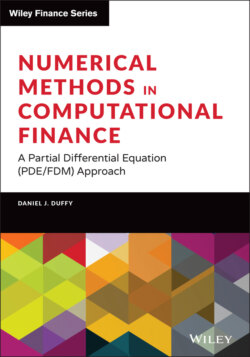Читать книгу Numerical Methods in Computational Finance - Daniel J. Duffy - Страница 19
1.2.3 Uniform Continuity
ОглавлениеIn general terms, uniform continuity guarantees that f (x) and f (y) can be made as close to each other as we please by requiring that x and y be sufficiently close to each other. This is in contrast to ordinary continuity, where the distance between f (x) and f (y) may depend on x and y themselves. In other words, in Definition 1.1 depends only on and not on the points in the domain. Continuity itself is a local property because a function f is or is not continuous at a particular point and continuity can be determined by looking at the values of the function in an arbitrary small neighbourhood of that point. Uniform continuity, on the other hand, is a global property of f because the definition refers to pairs of points rather than individual points. The new definition in this case for a function f defined in an interval I is:
Let us take an example of a uniformly continuous function:
(1.4)
Then
Choose .
In general, a continuous function on a closed interval is uniformly continuous. An example is:
(1.5)
Let . Then:
Choose .
An example of a function that is continuous and nowhere differentiable is the Weierstrass function that we can write as a Fourier series:
(1.6)
b is a positive odd integer and .
This is a jagged function that appears in models of Brownian motion. Each partial sum is continuous, and hence by the uniform limit theorem (which states that the uniform limit of any sequence of continuous functions is continuous), the series (1.6) is continuous.
